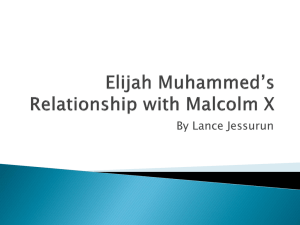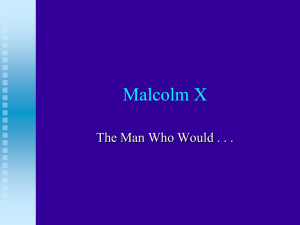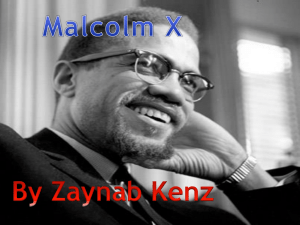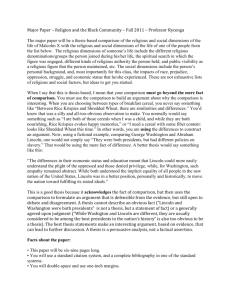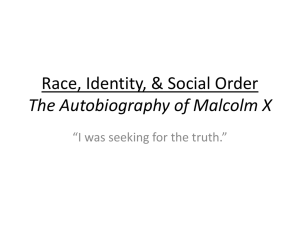80.36 KB - EngageNY
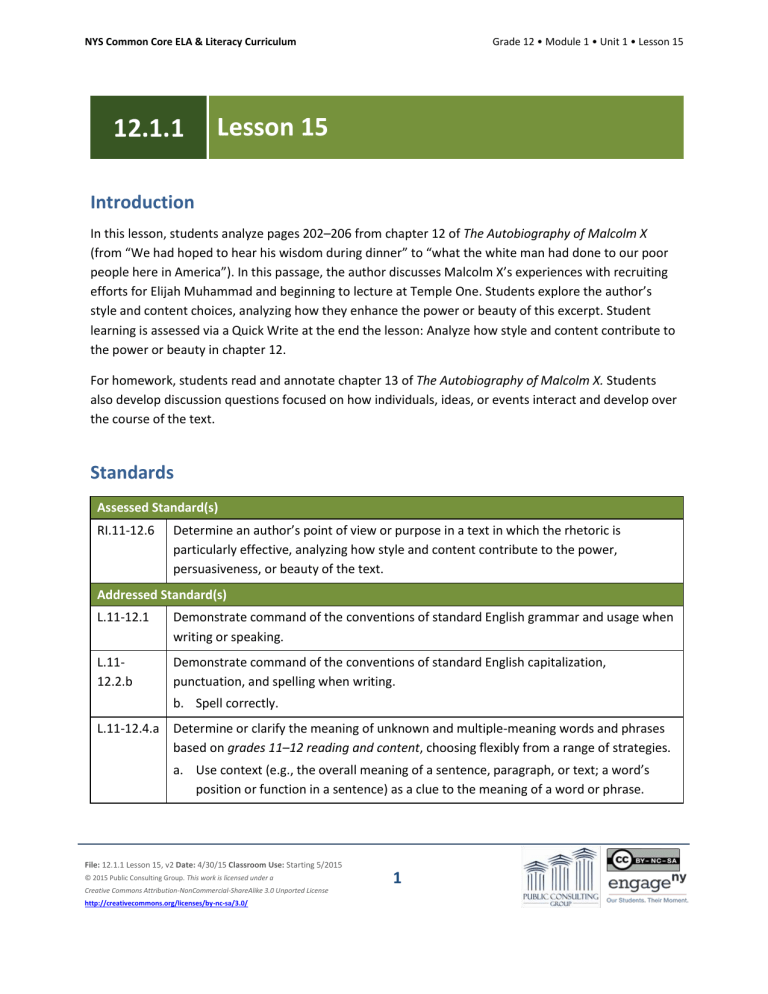
NYS Common Core ELA & Literacy Curriculum
12.1.1 Lesson 15
Grade 12 • Module 1 • Unit 1 • Lesson 15
Introduction
In this lesson, students analyze pages 202–206 from chapter 12 of The Autobiography of Malcolm X
(from “We had hoped to hear his wisdom during dinner” to “what the white man had done to our poor people here in America”). In this passage, the author discusses Malcolm X’s experiences with recruiting efforts for Elijah Muhammad and beginning to lecture at Temple One. Students explore the author’s style and content choices, analyzing how they enhance the power or beauty of this excerpt. Student learning is assessed via a Quick Write at the end the lesson: Analyze how style and content contribute to the power or beauty in chapter 12.
For homework, students read and annotate chapter 13 of The Autobiography of Malcolm X. Students also develop discussion questions focused on how individuals, ideas, or events interact and develop over the course of the text.
Standards
Assessed Standard(s)
RI.11-12.6 Determine an author’s point of view or purpose in a text in which the rhetoric is particularly effective, analyzing how style and content contribute to the power, persuasiveness, or beauty of the text.
Addressed Standard(s)
L.11-12.1 Demonstrate command of the conventions of standard English grammar and usage when writing or speaking.
L.11-
12.2.b
Demonstrate command of the conventions of standard English capitalization, punctuation, and spelling when writing. b.
Spell correctly.
L.11-12.4.a Determine or clarify the meaning of unknown and multiple-meaning words and phrases based on grades 11–12 reading and content, choosing flexibly from a range of strategies. a.
Use context (e.g., the overall meaning of a sentence, paragraph, or text; a word’s position or function in a sentence) as a clue to the meaning of a word or phrase.
File: 12.1.1 Lesson 15, v2 Date: 4/30/15 Classroom Use: Starting 5/2015
© 2015 Public Consulting Group. This work is licensed under a
Creative Commons Attribution-NonCommercial-ShareAlike 3.0 Unported License http://creativecommons.org/licenses/by-nc-sa/3.0/
1
NYS Common Core ELA & Literacy Curriculum Grade 12 • Module 1 • Unit 1 • Lesson 15
Assessment
Assessment(s)
Student learning is assessed via a Quick Write at the end of the lesson. Students respond to the following prompt, citing textual evidence to support analysis and inferences drawn from the text.
Analyze how style and content contribute to the power or beauty in chapter 12.
High Performance Response(s)
A High Performance Response should:
Identify at least one example of a stylistic choice that contributes to the power or beauty of chapter 12 (e.g., The author focuses on Malcolm X’s early experiences lecturing Nation of Islam followers at Temple One in Detroit. The author uses juxtaposition to explain that when Malcolm X lectures now he “rarely feel[s] as much electricity as was then generated in [him]” (p.205) when he was only beginning to lecture at Temple One in Detroit.).
Identify at least one example of a content choice that contributes to the power or beauty of chapter 12 (e.g., To highlight Malcolm X’s early experiences speaking to Nation of Islam followers, the author includes quotations of the content from Malcolm X’s lectures about the horrors of slavery. The quotations the author includes focus on the degrading and harmful effects of the slave masters’ rape of African-American women: “‘That rapist slavemaster who emasculated the black man … until even today the black man lives with fear of the white man in his heart’” (p. 206).).
Analyze how these stylistic and content choices contribute to the power or beauty of chapter 12
(e.g., Through the stylistic choice of juxtaposition, the author emphasizes the extent to which
Malcolm X feels stimulated and energized during his early experiences lecturing to Nation of Islam followers. Malcolm X now has “audiences of millions” who can hear his message through “radio and television microphones,” which the author juxtaposes with Malcolm X’s early experiences lecturing to only “those seventy-five or a hundred Muslims” who were physically in front of him in their modest “storefront temple with the squealing of pigs filtering in from the slaughterhouse just outside” (p. 205). The author’s stylistic choice of juxtaposition contributes to the power of the excerpt by highlighting how different Malcolm X felt as a young minister. By including quotations from Malcolm X’s early lectures, the author demonstrates the typical content in Malcolm X’s speeches that would move him so much: “Think of hearing wives, mothers, daughters, being
raped! And you were too filled with fear of the rapist to do anything about it!” (p. 206). Because rape is such an emotionally intense topic that is difficult for many people to hear discussed, the quotation shocks the reader and develops the emotional intensity of the excerpt. Sharing the content of the lectures serves to generate the same “electricity” (p. 205) in the reader that
Malcolm X feels while speaking on these topics, which contributes to the overall power of the excerpt.).
File: 12.1.1 Lesson 15, v2 Date: 4/30/15 Classroom Use: Starting 5/2015
© 2015 Public Consulting Group. This work is licensed under a
Creative Commons Attribution-NonCommercial-ShareAlike 3.0 Unported License http://creativecommons.org/licenses/by-nc-sa/3.0/
2
NYS Common Core ELA & Literacy Curriculum Grade 12 • Module 1 • Unit 1 • Lesson 15
Vocabulary
Vocabulary to provide directly (will not include extended instruction)
extemporaneous (adj.) – done, spoken, performed, etc. without special advance preparation
gall (n.) – bitterness of spirit
Vocabulary to teach (may include direct word work and/or questions)
rebuffed (v.) – rejected or criticized sharply
Additional vocabulary to support English Language Learners (to provide directly)
lull (n.) – a brief time when action or activity stops – usually + in
forebears (n.) – members of your family in the past
reel (v.) – to be very shocked, confused, and upset
Plymouth Rock (n.) – a rock at Plymouth, Massachusetts, on which the Pilgrims who sailed on the
Mayflower are said to have stepped ashore when they landed in America in 1620
Lesson Agenda/Overview
Student-Facing Agenda
Standards & Text:
Standards: RI.11-12.6, L.11-12.1, L.11-12.2.b, L.11-12.4.a
Text: The Autobiography of Malcolm X as told to Alex Haley, Chapter 12, pages 202–206
Learning Sequence:
1.
Introduction of Lesson Agenda
2.
Homework Accountability
3.
Reading and Discussion
4.
Quick Write and Editing
5.
Closing
% of Lesson
1.
10%
2.
15%
3.
50%
4.
20%
5.
5%
Materials
Student copies of the 12.1 Common Core Learning Standards Tool (refer to 12.1.1 Lesson 1)
(optional)
File: 12.1.1 Lesson 15, v2 Date: 4/30/15 Classroom Use: Starting 5/2015
© 2015 Public Consulting Group. This work is licensed under a
Creative Commons Attribution-NonCommercial-ShareAlike 3.0 Unported License http://creativecommons.org/licenses/by-nc-sa/3.0/
3
NYS Common Core ELA & Literacy Curriculum Grade 12 • Module 1 • Unit 1 • Lesson 15
Student copies of the Style and Content Tool (refer to 12.1.1 Lesson 5) (optional)—students may need additional blank copies
Student copies of the Short Response Rubric and Checklist (refer to 12.1.1 Lesson 1)
Learning Sequence
How to Use the Learning Sequence
Symbol Type of Text & Interpretation of the Symbol
10% Percentage indicates the percentage of lesson time each activity should take.
Plain text indicates teacher action. no symbol
Bold text indicates questions for the teacher to ask students.
Italicized text indicates a vocabulary word.
Indicates student action(s).
Indicates possible student response(s) to teacher questions.
Indicates instructional notes for the teacher.
Activity 1: Introduction of Lesson Agenda 10%
Begin by reviewing the agenda and the assessed standard for this lesson: RI.11-12.6. In this lesson, students read and discuss a section of text from chapter 12 of The Autobiography of Malcolm X.
Students explore the author’s style and content choices, analyzing how they enhance the power or beauty of this excerpt.
Students look at the agenda.
Differentiation Consideration: If students are using the 12.1 Common Core Learning Standards Tool, instruct them to refer to it for this portion of the lesson introduction.
Post or project standards L.11-12.1 and L.11-12.2.b. Instruct students to talk in pairs about what they think each standard means. Lead a brief discussion about the standards.
Student responses should include: o Students should use grammar correctly and communicate without slang in both writing and discussion. o During writing assignments, students should follow the rules for capitalization and punctuation and spell correctly.
Review rules for capitalization, punctuation, and spelling as necessary.
File: 12.1.1 Lesson 15, v2 Date: 4/30/15 Classroom Use: Starting 5/2015
© 2015 Public Consulting Group. This work is licensed under a
Creative Commons Attribution-NonCommercial-ShareAlike 3.0 Unported License http://creativecommons.org/licenses/by-nc-sa/3.0/
4
NYS Common Core ELA & Literacy Curriculum Grade 12 • Module 1 • Unit 1 • Lesson 15
Activity 2: Homework Accountability 15%
Instruct students to take out their responses to the previous lesson’s homework assignment. (Read and annotate chapter 12 of The Autobiography of Malcolm X and develop 2–3 discussion questions focused on how style and content contribute to the power or beauty of the text (RI.11-12.6). Prepare possible answers to your questions for discussion.)
Instruct students to talk in pairs about questions they developed for homework, specifically discussing the author’s point of view or purpose and the contribution of style and content to the power or beauty of the text.
Student questions may include:
How does the description of “the Muslim home routine” (p. 197) contribute to the power of the text?
By “patiently” sharing the step-by-step routine typical in “the Muslim home” (p. 197) the author emphasizes Malcolm X’s interest in the routine. The description contributes to the power of the text because the reader, like Malcolm X, witnesses and understands “[e]ach act, and the significance of that act” (p. 197) and is captivated by the routine.
What is the rhetorical impact of the last sentence in the chapter: “In the years to come, I was going to have to face a psychological and spiritual crisis” (p. 214)?
In the section of text immediately preceding this sentence, the author emphasizes Malcolm
X’s faith in and dedication to Elijah Muhammad, perhaps hinting at the content of the
“psychological and spiritual crisis” to come (p. 214). Because the reader does not know exactly why or when Malcolm X will have this crisis, especially since the preceding section is nothing but positive about Elijah Muhammad, the author’s stylistic choice to use foreshadowing contributes to the power of the excerpt by building suspense and tension.
Consider informing students that the last sentence of chapter 12 is an example of foreshadowing. If necessary, remind students of their work with foreshadowing in 12.1.1 Lesson 11.
If student discussion is rich, text-dependent, and building toward the assessment prompt, consider extending the discussions beyond the allotted time. Then lead a brief, whole-class discussion using any additional Reading and Discussion questions necessary to ensure students are prepared for the assessment. (Key questions are marked with an asterisk*.)
File: 12.1.1 Lesson 15, v2 Date: 4/30/15 Classroom Use: Starting 5/2015
© 2015 Public Consulting Group. This work is licensed under a
Creative Commons Attribution-NonCommercial-ShareAlike 3.0 Unported License http://creativecommons.org/licenses/by-nc-sa/3.0/
5
NYS Common Core ELA & Literacy Curriculum Grade 12 • Module 1 • Unit 1 • Lesson 15
Activity 3: Reading and Discussion 50%
Instruct students to form pairs. Post or project each set of questions below for students to discuss.
Instruct students to continue to annotate the text as they read and discuss.
If necessary to support comprehension and fluency, consider using a masterful reading of the focus excerpt for the lesson.
Instruct student pairs to read pages 202–204 (from “We had hoped to hear his wisdom during dinner” to
“And I worshipped him” and answer the following questions before sharing out with the class.
Differentiation Consideration: Consider providing students with the following definitions: lull means
“a brief time when action or activity stops” and forebears means “members of your family in the past.”
Students write the definitions of lull and forebears on their copies of the text or in a vocabulary journal.
Differentiation Consideration: Consider posting or projecting the following guiding question to support students in their reading throughout the lesson:
What makes the text powerful or beautiful?
What does it mean that Malcolm X “found [his] tongue” (p. 202)? How does this description develop the reader’s understanding of Malcolm X’s point of view?
The phrase “found [his] tongue” (p. 202) is a figurative way of showing that Malcolm X is inspired to speak, and he knows what he wants to say. The stylistic choice to use figurative language in a simple, direct sentence emphasizes that Malcolm X views this moment as important. This description implies that prior to this discussion, Malcolm X had not felt ready to engage Mr. Muhammad in this way, highlighting Malcolm X’s view that his first dinner with
Elijah Muhammad is a pivotal experience for him.
Consider explaining to students that this is an example of a rhetorical device or stylistic choice called
metonymy. Define metonymy for students as “the use of some aspect of a person, object or idea to represent that person, object or idea.” For example, to state that Malcolm X “found [his] tongue” (p.
202), is to show that he found the inspiration and power to speak.
Differentiation Consideration: Students may use their Style and Content Tools to record this definition and example of metonymy.
*How does receiving the “X” affect Malcolm X? What words and phrases emphasize this effect?
File: 12.1.1 Lesson 15, v2 Date: 4/30/15 Classroom Use: Starting 5/2015
© 2015 Public Consulting Group. This work is licensed under a
Creative Commons Attribution-NonCommercial-ShareAlike 3.0 Unported License http://creativecommons.org/licenses/by-nc-sa/3.0/
6
NYS Common Core ELA & Literacy Curriculum Grade 12 • Module 1 • Unit 1 • Lesson 15
Receiving the “X” is important to Malcolm X, because it allows him to reject “the white slavemaster name” (p. 203) and embrace and display his new identity. By using the phrase
“forever after” (p. 203), the author emphasizes the importance and finality of Malcolm X’s new identity.
*How does the author describe the people Malcolm X tries to recruit in Detroit? What makes this description powerful or beautiful?
Student responses may include: o The author describes the people Malcolm X tries to recruit as “poor, ignorant, brainwashed black brothers mostly too deaf, dumb, and blind, mentally, morally, and spiritually to respond” (p. 203). This description is powerful, because the alliteration and repetitive word endings intensify Malcolm X’s feelings of pity, anger, and frustration toward the people he tries to help. o The alliteration and repetitive word endings create an engaging rhythm that distinguishes the sentence from the rest of the paragraph, enhancing both the beauty and power of the description. o Because the African Americans Malcolm X tries to recruit are not actually “too deaf, dumb, and blind,” the figurative language exaggerates these men’s conditions, which emphasizes
Malcolm X’s deep concern for them (p. 203).
If necessary, explain to students that the description “too deaf, dumb, and blind” is an example of hyperbole. Define hyperbole as “obvious and intentional exaggeration.”
Differentiation Consideration: Students may use their Style and Content Tools to record this definition and example of hyperbole.
What is the rhetorical impact of the image of “each month, a few more automobiles lengthened our caravans” (p. 203)?
With this image, the author shows that “[g]radually, enough were made interested” (p. 203) by
Malcolm X’s recruitment efforts. The author’s stylistic choice to use imagery to convey the sense of growth adds to the beauty of the excerpt. Through imagery, the author is not merely reporting the fact that membership in the Nation of Islam grew; instead, the image allows the reader to vividly picture more and more cars traveling to Chicago, which is a more beautiful way than listing a statistic to convey the sense of growth.
*How does the author emphasize Malcolm X’s opinion of Elijah Muhammad?
Student responses may include:
File: 12.1.1 Lesson 15, v2 Date: 4/30/15 Classroom Use: Starting 5/2015
© 2015 Public Consulting Group. This work is licensed under a
Creative Commons Attribution-NonCommercial-ShareAlike 3.0 Unported License http://creativecommons.org/licenses/by-nc-sa/3.0/
7
NYS Common Core ELA & Literacy Curriculum Grade 12 • Module 1 • Unit 1 • Lesson 15 o The author creates an abrupt shift in sentence structure by using the short sentence “And I worshipped him” (p. 204) as its own paragraph, which is jarring to the reader. By varying syntax for effect, the author places special emphasis on the meaning of this sentence, highlighting just how important Elijah Muhammad is to Malcolm X. o By using the word worshipped (p. 204), the author emphasizes that Malcolm X views Elijah
Muhammad as someone so important that he acts toward him as he would act toward God.
Differentiation Consideration: Consider extending students’ analysis of the sentence “And I worshipped him” (p. 204) with the following question:
What is the impact of the word “worshipped” (p. 204)?
Through the word “worshipped” (p. 204), the author compares Malcolm X’s feelings about Elijah
Muhammad to how a religious person acts toward his or her god. The word “worshipped” emphasizes the extent to which Malcolm X respects and glorifies Elijah Muhammad. Because
Malcolm X reveres Elijah Muhammad like a god, he feels “honored” whenever Elijah
Muhammad invites them for dinner or pays them “a personal visit” (p. 204).
Lead a brief whole-class discussion of student responses.
Differentiation Consideration: Students may use their Style and Content Tools to record the stylistic and content choices they identified and discussed.
Instruct student pairs to read pages 204–206 (from “In early 1953, I left the furniture store” to “what the white man had done to our poor people here in America”) and answer the following questions before sharing out with the class.
Provide students with the following definitions: extemporaneous means “done, spoken, performed, etc. without special advance preparation” and gall means “bitterness of spirit.”
Students may be familiar with some of these words. Consider asking students to volunteer definitions before providing them to the group.
Students write the definitions of extemporaneous and gall on their copies of the text or in a vocabulary journal.
Differentiation Consideration: Consider providing students with the following definitions: reel means “to be very shocked, confused, and upset” and Plymouth Rock is “a rock at Plymouth,
Massachusetts, on which the Pilgrims who sailed on the Mayflower are said to have stepped ashore when they landed in America in 1620.”
File: 12.1.1 Lesson 15, v2 Date: 4/30/15 Classroom Use: Starting 5/2015
© 2015 Public Consulting Group. This work is licensed under a
Creative Commons Attribution-NonCommercial-ShareAlike 3.0 Unported License http://creativecommons.org/licenses/by-nc-sa/3.0/
8
NYS Common Core ELA & Literacy Curriculum Grade 12 • Module 1 • Unit 1 • Lesson 15
Students write the definitions of reel and Plymouth Rock on their copies of the text or in a vocabulary journal.
As this section of text contains material relating to the rape of slaves by white men and the cumulative impact of these individual actions on the larger African American community, consider establishing and modeling classroom norms and expectations for a respectful and critical academic discussion.
*What comparison does the author make between when Malcolm X speaks “[t]oday” (p. 205) and when he first lectured at Temple One? How does this comparison contribute to the power of the excerpt?
The author juxtaposes Malcolm X’s present experiences lecturing to “audiences of millions” using the sophistication of “radio and television microphones” to when he first began lecturing in front of only “seventy-five or a hundred Muslims” in the comparatively humble “storefront temple with the squealing of pigs filtering in from the slaughterhouse just outside” (p. 205).
Because millions now hear his message, it may not be clear why Malcolm X “rarely feel[s] as much electricity as was then generated in [him]” (p. 205). However, the juxtaposition draws attention to the emotional significance of Malcolm X’s early lecturing experiences, thereby contributing to the power of the excerpt.
If necessary, remind students of their work with juxtaposition in 12.1.1 Lesson 10.
What does Malcolm X feel toward his “poor blind black brothers” when they “rebuff[]” Mr.
Muhammad’s teachings (p. 205)? What words and phrases clarify the meaning of rebuffed in this context?
Malcolm X feels “anger and pity” (p. 205) when he tries to talk to African Americans about Elijah
Muhammad’s teachings and the teachings are “rebuffed and even ridiculed” (p. 205). Since these people seem to be dismissing and making fun of Elijah Muhammad’s teachings, then
rebuffed likely means “rejected or criticized sharply.”
Consider drawing students’ attention to their application of standard L.11-12.4.a through the process of using context as a clue to determine the meaning of a word.
*How does the inclusion of the quotations from Malcolm X’s lectures develop the author’s purpose in this excerpt?
Student responses may include: o By including quotations from Malcolm X’s lectures, the author exposes the reader to
Malcolm X’s speaking style and content. Though Malcolm X “had never felt remotely
File: 12.1.1 Lesson 15, v2 Date: 4/30/15 Classroom Use: Starting 5/2015
© 2015 Public Consulting Group. This work is licensed under a
Creative Commons Attribution-NonCommercial-ShareAlike 3.0 Unported License http://creativecommons.org/licenses/by-nc-sa/3.0/
9
NYS Common Core ELA & Literacy Curriculum Grade 12 • Module 1 • Unit 1 • Lesson 15 qualified to directly represent Mr. Muhammad” (p. 204), the inclusion of the quotations demonstrates that Malcolm X is indeed ready to speak on behalf of the Nation of Islam. o The author’s inclusion of quotations is a powerful way to demonstrate Malcolm X’s readiness to become a minister because the quotations transport the reader into Malcolm
X’s audience, giving the reader a more physical experience of what it would have been like to hear powerful phrases like “’We have accepted it! We have embraced it! We have
believed it! We have practiced it!’” (p. 205).
*How does the content of the quoted lectures contribute to the power of this excerpt?
Student responses may include: o The quotations focus on Malcolm X’s descriptions of “‘[t]hat rapist slavemaster who emasculated the black man’” and how the rape of African-American women affected and continues to affect African Americans’ condition and identity, since “‘even today the black man lives with fear of the white man in his heart’” (p. 206). Because rape is such an emotionally charged topic that is difficult for many people to discuss, the quotations shock the reader and develop the emotional intensity of the excerpt. o The quoted lectures include Malcolm X’s description of his struggle with his racial identity in the context of all African Americans being “’polluted by [the] devil white man’” (p. 206), which connects to an experience that his audience shared. The inclusion of Malcolm X’s description of his racial identity and his “‘raping, red-headed devil … grandfather’” (p. 206) contributes to the power of the passage because it is a deeply personal experience.
What does it mean to “become so choked up” (p. 206)? How does this description develop the reader’s understanding of Malcolm X’s point of view?
The author uses figurative language to mean that Malcolm X is so overcome with emotion
“thinking to [himself] about what the white man had done to our poor people here in America”
(p. 206) that it is like he cannot breathe or say anything at all. Malcolm X’s reflection on the issues he brings up during his speaking experience indicates how strongly he feels about the condition of African Americans.
Lead a brief whole-class discussion of student responses.
Differentiation Consideration: Students may use their Style and Content Tools to record the instances of stylistic or content choices they identified and discussed.
File: 12.1.1 Lesson 15, v2 Date: 4/30/15 Classroom Use: Starting 5/2015
© 2015 Public Consulting Group. This work is licensed under a
Creative Commons Attribution-NonCommercial-ShareAlike 3.0 Unported License http://creativecommons.org/licenses/by-nc-sa/3.0/
10
NYS Common Core ELA & Literacy Curriculum Grade 12 • Module 1 • Unit 1 • Lesson 15
Activity 4: Quick Write and Editing 20%
Instruct students to respond briefly in writing to the following prompt:
Analyze how style and content contribute to the power or beauty in chapter 12.
Instruct students to look at their annotations to find evidence. Ask students to use this lesson’s vocabulary wherever possible in their written responses. Remind students to use the Short Response
Rubric and Checklist to guide their written responses.
Students listen and read the Quick Write prompt.
Display the prompt for students to see, or provide the prompt in hard copy.
Transition to the independent Quick Write.
Students independently answer the prompt using evidence from the text.
See the High Performance Response at the beginning of this lesson.
Transition students to editing their Quick Writes. Instruct students to edit their Quick Writes for proper grammar, capitalization, punctuation, and spelling according to standards L.11-12.1 and L.11-12.2.
If possible provide online or hardcopy dictionaries as necessary.
Students independently edit their Quick Writes.
Activity 5: Closing 5%
Display and distribute the homework assignment. For homework, instruct students to read and annotate chapter 13 of The Autobiography of Malcolm X and develop 2–3 discussion questions focused on how individuals, ideas, or events interact and develop over the course of the text (RI.11-12.3).
Instruct students to prepare possible answers to their questions for discussion.
Students follow along.
For Accountable Independent Writing homework, instruct students to continue drafting their personal narratives. Students may continue the draft they have been working on or choose to respond to a new Common Application prompt that better allows them to fulfill their statements of purpose. Remind students to focus on using narrative techniques, such as dialogue, pacing, description, reflection, and multiple plot lines, to develop experiences, events, and/or characters.
Students may post their drafts to the class’s online writing community and be paired for peer review. Remind peer reviewers to consider how effectively their peer uses narrative techniques,
File: 12.1.1 Lesson 15, v2 Date: 4/30/15 Classroom Use: Starting 5/2015
© 2015 Public Consulting Group. This work is licensed under a
Creative Commons Attribution-NonCommercial-ShareAlike 3.0 Unported License http://creativecommons.org/licenses/by-nc-sa/3.0/
11
NYS Common Core ELA & Literacy Curriculum Grade 12 • Module 1 • Unit 1 • Lesson 15 such as dialogue, pacing, description, reflection, and multiple plot lines, to develop experiences, events, and/or characters.
Homework
Read and annotate chapter 13 of The Autobiography of Malcolm X and develop 2–3 discussion questions focused on how individuals, ideas, or events interact and develop over the course of the text (RI.11-
12.3). Prepare possible answers to your questions for discussion.
File: 12.1.1 Lesson 15, v2 Date: 4/30/15 Classroom Use: Starting 5/2015
© 2015 Public Consulting Group. This work is licensed under a
Creative Commons Attribution-NonCommercial-ShareAlike 3.0 Unported License http://creativecommons.org/licenses/by-nc-sa/3.0/
12
NYS Common Core ELA & Literacy Curriculum Grade 12 • Module 1 • Unit 1 • Lesson 15
Model Style and Content Tool
Name: Class: Date:
Directions: Use this tool to track the stylistic or content choices you encounter in the text, as well as examples and explanations of these choices. Be sure to note the rhetorical effect of each choice on the text.
RI.11-12.6: Determine an author’s point of view or purpose in a text in which the rhetoric is particularly effective, analyzing how style and content contribute to the power, persuasiveness, or beauty of the text.
Rhetoric: the specific techniques that writers or speakers use to create meaning in a text, enhance a text or a lecture, and often, persuade readers or listeners
Style: how the author expresses content, which frequently includes the use of figurative language or rhetorical devices
Content: what the author writes, including events, ideas, and details the author chooses to include
Point of View: an author’s opinion, attitude, or judgment
Purpose: an author’s reason for writing
Example of style (figurative language or rhetorical device) or content (events, ideas, details) (with page reference)
Rhetorical effect (power, beauty, point of view, purpose)
The author uses foreshadowing the last sentence of the chapter: “In the years to come, I was going to have to face a psychological and spiritual crisis”
(p. 214).
Because the reader does not know exactly why or when Malcolm X will have this crisis, especially since the preceding section is nothing but positive about Elijah Muhammad, the author’s stylistic choice to use foreshadowing contributes to the power of the excerpt by building suspense and tension.
The author uses metonymy when he writes that
Malcolm X “found [his] tongue” during the first dinner he has with Elijah Muhammad (p. 202).
Metonymy: the use of some aspect of a person, object, or idea to represent that person, object, or idea
Using figurative language in a simple, direct sentence emphasizes the importance of the moment to Malcolm X, which demonstrates
Malcolm X’s point of view that his first dinner with Elijah Muhammad is a pivotal experience for him.
File: 12.1.1 Lesson 15, v2 Date: 4/30/15 Classroom Use: Starting 5/2015
© 2015 Public Consulting Group. This work is licensed under a
Creative Commons Attribution-NonCommercial-ShareAlike 3.0 Unported License http://creativecommons.org/licenses/by-nc-sa/3.0/
13
NYS Common Core ELA & Literacy Curriculum Grade 12 • Module 1 • Unit 1 • Lesson 15
The author uses alliteration when he describes the people Malcolm X tries to recruit in Detroit as
“poor, ignorant, brainwashed black brothers mostly too deaf, dumb, and blind, mentally, morally, and spiritually to respond” (p. 203).
This description is powerful, because the alliteration and repetitive word endings intensify
Malcolm X’s feelings of pity, anger, and frustration toward the people he believes he is trying to help.
The alliteration and repetitive word endings create an engaging rhythm that distinguishes the sentence from the rest of the paragraph, enhancing both the beauty and power of the description.
The author uses hyperbole when he describes the people Malcolm X tries to recruit in Detroit as
“too deaf, dumb, and blind” (p. 203).
Hyperbole: obvious and intentional exaggeration
The hyperbole exaggerates these men’s conditions, which emphasizes Malcolm X’s low opinion of them and adds to the power of the description.
To convey a sense of growth, the author uses the image of “a few more automobiles lengthened our caravans” (p. 203).
The author varies his syntax for stylistic effect with an abrupt, short sentence: “And I worshipped him” (p. 204).
The author uses juxtaposition to compare
Malcolm X’s present experiences lecturing to
“audiences of millions” using the sophistication of
“radio and television microphones” to when he first began lecturing in front of only “seventy-five or a hundred Muslims” in the comparatively humble “storefront temple with the squealing of pigs filtering in from the slaughterhouse just outside” (p. 205).
Through imagery, the author is not merely reporting the fact that membership in the Nation of Islam grew; instead, imagery contributes to the beauty of the text by allowing the reader to vividly picture more and more cars traveling to
Chicago, which is a more beautiful way than listing a statistic to convey the sense of growth.
As a short sentence in its own paragraph, the author creates an abrupt shift in sentence structure, which is jarring to the reader. By varying syntax for effect, the author places special emphasis on the meaning of this sentence, highlighting just how important Elijah Muhammad is to Malcolm X, which shows Malcolm X’s point of view.
Because millions now hear his message, it may not be clear why Malcolm X “rarely feel[s] as much electricity as was then generated in [him]”
(p. 205). However, the juxtaposition draws attention to the emotional significance of
Malcolm X’s early lecturing experiences, thereby contributing to the power of the excerpt.
File: 12.1.1 Lesson 15, v2 Date: 4/30/15 Classroom Use: Starting 5/2015
© 2015 Public Consulting Group. This work is licensed under a
Creative Commons Attribution-NonCommercial-ShareAlike 3.0 Unported License http://creativecommons.org/licenses/by-nc-sa/3.0/
14
NYS Common Core ELA & Literacy Curriculum Grade 12 • Module 1 • Unit 1 • Lesson 15
The author includes quotations of the content from Malcolm X’s lectures about the horrors of slavery (pp. 205–206, from “’We didn’t land on
Plymouth Rock, my brothers and sisters’” to “’and the gall to think we, his victims, should love him!’”).
By including quotations from Malcolm X’s early lectures, the author demonstrates the typical content in Malcolm X’s speeches that would move him so much. Because rape is such an emotionally intense topic that is difficult for many people to hear discussed, the content shocks the reader.
This example develops the emotional intensity, which contributes to the overall power of the excerpt.
The author uses figurative language, describing
Malcolm X as feeling “so choked up” (p. 206) after lecturing on the horrors of slavery.
The author’s use of figurative language to show that Malcolm X is so overcome with emotion that it is like he cannot breathe or speak indicates how strongly Malcolm X feels about the condition of
African Americans, which demonstrates Malcolm
X’s point of view.
File: 12.1.1 Lesson 15, v2 Date: 4/30/15 Classroom Use: Starting 5/2015
© 2015 Public Consulting Group. This work is licensed under a
Creative Commons Attribution-NonCommercial-ShareAlike 3.0 Unported License http://creativecommons.org/licenses/by-nc-sa/3.0/
15
